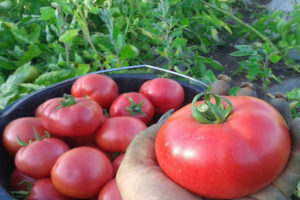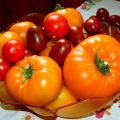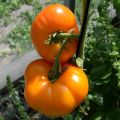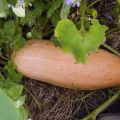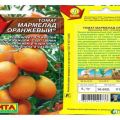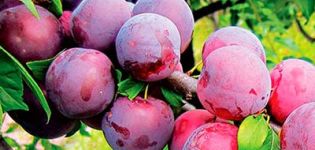Characteristics and description of the variety of tomato Banana orange
Greenhouse tomato Banana orange has gained popularity in Central Russia. It was bred by breeding for a given climatic zone. The tomato has a rich color, pleasant taste with a slight sourness. It got its name due to the similarity of the bunch of ripe fruits with a bunch of bananas in shape and color.
Banana tomatoes are an indeterminate plant, up to 1.5 meters high. A plant with a sturdy stem, leaves like a tomato. Not bushy. Forms inflorescences above 8-9 leaves, each of which has about eight fruits.

The characteristics and description of the variety describe the fact that the plant begins to bear fruit 90-100 days after seed germination. Elongated, uniform pearlescent orange vegetables have a pleasant honey taste, there is a slight tomato acidity. Fruits weighing up to 100-150 grams each, 5-7 cm long, fleshy, with few seeds. The yield from a bush reaches 3.5 kilograms.
The fruits are used raw, added to hot dishes, and are appreciated for making juices and pasta. The thin peel, which does not undergo cracking, and the small size of the fruit make it effective for canning. Heat treatment does not reduce the amount of vitamins in the final product.
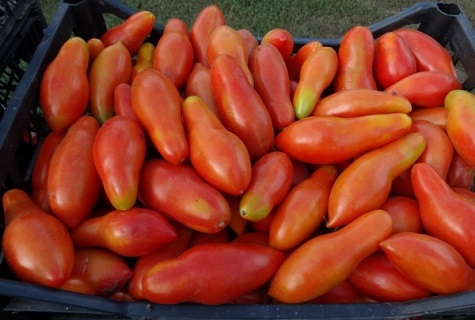
The advantages of growing a variety
Lab-bred Orange Banana has special characteristics that set it apart from others:
- differ in average productivity from one bush;
- bears fruit all warm season;
- has a rich taste;
- attracts with colors;
- resembles a plum in shape;
- resistant to common diseases of tomatoes - late blight, cladosporiosis, fusarium;
- stored for a long time after being removed from the bush, can ripen in a dark, cool place;
- fruits on bushes, planted at the same time, also ripen together, which makes them easy to preserve. You can pick up to 30-40 fruits from a bush at a time;
- in more favorable climatic zones it is grown in the open field, in the warm summer period with a small loss in yield it is grown in central Russia.
Tomatoes of this variety are well used for sale, as they have a long shelf life, uniform ripening, and a pleasant taste. During transportation, they do not rot, do not crumple, keeping their marketable appearance. For home purposes, they are also stored for a long time without creating special storage conditions.
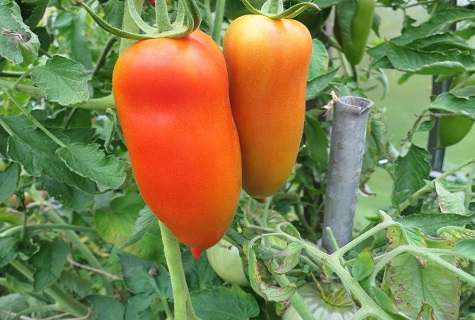
Features of plant care
Tomato seeds, which have good germination, are planted in mid-March to obtain seedlings. They must be treated with potassium permanganate solution or Zircon.The soil is chosen not acidic, previously disinfected with potassium permanganate. It can be purchased in a store or prepared in advance from a mixture of earth with humus, sand, peat, ash.
For seed germination, a container up to 2 cm deep is sufficient. Having received the first well-developed leaf, the plant should be transplanted. A peat or paper container with a diameter of 15 centimeters is best suited for seedlings. If you planted seeds in an individual container, transplanting is not required.
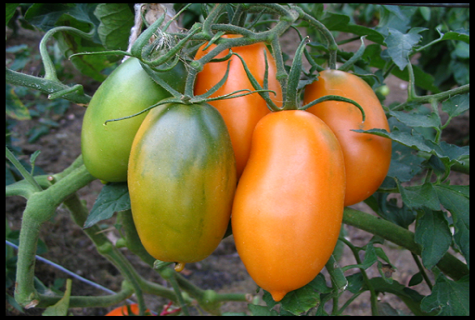
Landing in a greenhouse is carried out at the age of seedlings about 65 days, by mid-May. When used outdoors - when the threat of cold weather has passed. The variety tolerates transplanting and almost does not get sick. The checkerboard planting order is used most often in connection with the extensive development of the root system. For the same reason, the distance between plants should be from 50 centimeters, between beds - from 60 cm. You can also plant seedlings in a two-row way.
A tomato bush should be formed with one stem, removing stepchildren every ten days. It is imperative to tie up plants on previously prepared supports.
These requirements are often applied to tomatoes and will not pose any particular problems in the care of the plant.
Prevention of plant disease
Protect plants of the Orange Banana tomato variety from pests in advance, by spraying with copper sulfate. For the purpose of prevention, the mode of airing the greenhouse, watering and loosening the earth is observed. This is evidenced by the reviews of those who planted.
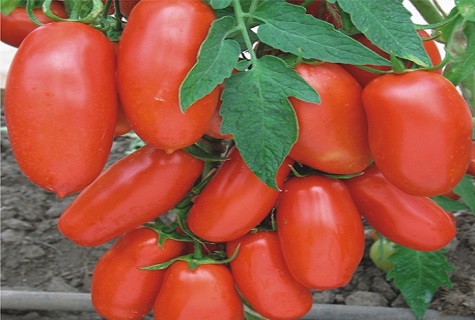
The plant is initially protected from Fusarium and Cladosporium. They are not afraid of late blight, in which parasites spread to the entire plant. To prevent the spread of aphids, ticks, and wireworms, special preparations are used.
The variety requires regular feeding of the plant, about once every 10-15 days. Using different drugs or folk infusions, you can improve the volume and quality of the crop. Particular attention should be paid to plants during flowering and fruit ripening.
The Banana Orange tomato variety is popular for indoor use. It has a stable yield. The fruits are distinguished by their original taste, color and shape. In care, the plant does not require special skills, not demanding. In warmer climates, it was grown in the open field with practically no loss of yield.
